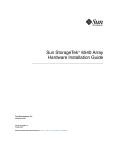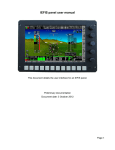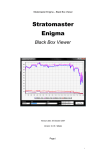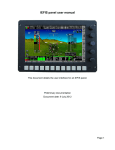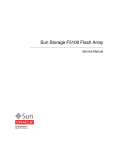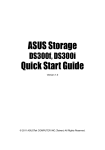Download Sun Storage 2500-M2 Arrays Site Preparation Guide
Transcript
Sun Storage 2500-M2 Arrays Site Preparation Guide Part No.: E20737-02 August 2011 Copyright © 2011, Oracle and/or its affiliates. All rights reserved. The Sun Storage 2500-M2 Arrays Site Preparation Guide describes facilities and system requirements for installing Sun Storage 2500-M2 Arrays. Follow the guidelines as outlined in this document when planning your installation. This software and related documentation are provided under a license agreement containing restrictions on use and disclosure and are protected by intellectual property laws. Except as expressly permitted in your license agreement or allowed by law, you may not use, copy, reproduce, translate, broadcast, modify, license, transmit, distribute, exhibit, perform, publish, or display any part, in any form, or by any means. Reverse engineering, disassembly, or decompilation of this software, unless required by law for interoperability, is prohibited. The information contained herein is subject to change without notice and is not warranted to be error-free. If you find any errors, please report them to us in writing. If this is software or related software documentation that is delivered to the U.S. Government or anyone licensing it on behalf of the U.S. Government, the following notice is applicable: U.S. GOVERNMENT RIGHTS. Programs, software, databases, and related documentation and technical data delivered to U.S. Government customers are "commercial computer software" or "commercial technical data" pursuant to the applicable Federal Acquisition Regulation and agency-specific supplemental regulations. As such, the use, duplication, disclosure, modification, and adaptation shall be subject to the restrictions and license terms set forth in the applicable Government contract, and, to the extent applicable by the terms of the Government contract, the additional rights set forth in FAR 52.227-19, Commercial Computer Software License (December 2007). Oracle America, Inc., 500 Oracle Parkway, Redwood City, CA 94065. This software or hardware is developed for general use in a variety of information management applications. It is not developed or intended for use in any inherently dangerous applications, including applications which may create a risk of personal injury. If you use this software or hardware in dangerous applications, then you shall be responsible to take all appropriate fail-safe, backup, redundancy, and other measures to ensure its safe use. Oracle Corporation and its affiliates disclaim any liability for any damages caused by use of this software or hardware in dangerous applications. Oracle and Java are registered trademarks of Oracle and/or its affiliates. Other names may be trademarks of their respective owners. AMD, Opteron, the AMD logo, and the AMD Opteron logo are trademarks or registered trademarks of Advanced Micro Devices. Intel and Intel Xeon are trademarks or registered trademarks of Intel Corporation. All SPARC trademarks are used under license and are trademarks or registered trademarks of SPARC International, Inc. UNIX is a registered trademark licensed through X/Open Company, Ltd. This software or hardware and documentation may provide access to or information on content, products, and services from third parties. Oracle Corporation and its affiliates are not responsible for and expressly disclaim all warranties of any kind with respect to third-party content, products, and services. Oracle Corporation and its affiliates will not be responsible for any loss, costs, or damages incurred due to your access to or use of third-party content, products, or services. Copyright © 2011, Oracle et/ou ses affiliés. Tous droits réservés. Ce logiciel et la documentation qui l’accompagne sont protégés par les lois sur la propriété intellectuelle. Ils sont concédés sous licence et soumis à des restrictions d’utilisation et de divulgation. Sauf disposition de votre contrat de licence ou de la loi, vous ne pouvez pas copier, reproduire, traduire, diffuser, modifier, breveter, transmettre, distribuer, exposer, exécuter, publier ou afficher le logiciel, même partiellement, sous quelque forme et par quelque procédé que ce soit. Par ailleurs, il est interdit de procéder à toute ingénierie inverse du logiciel, de le désassembler ou de le décompiler, excepté à des fins d’interopérabilité avec des logiciels tiers ou tel que prescrit par la loi. Les informations fournies dans ce document sont susceptibles de modification sans préavis. Par ailleurs, Oracle Corporation ne garantit pas qu’elles soient exemptes d’erreurs et vous invite, le cas échéant, à lui en faire part par écrit. Si ce logiciel, ou la documentation qui l’accompagne, est concédé sous licence au Gouvernement des Etats-Unis, ou à toute entité qui délivre la licence de ce logiciel ou l’utilise pour le compte du Gouvernement des Etats-Unis, la notice suivante s’applique : U.S. GOVERNMENT RIGHTS. Programs, software, databases, and related documentation and technical data delivered to U.S. Government customers are "commercial computer software" or "commercial technical data" pursuant to the applicable Federal Acquisition Regulation and agency-specific supplemental regulations. As such, the use, duplication, disclosure, modification, and adaptation shall be subject to the restrictions and license terms set forth in the applicable Government contract, and, to the extent applicable by the terms of the Government contract, the additional rights set forth in FAR 52.227-19, Commercial Computer Software License (December 2007). Oracle America, Inc., 500 Oracle Parkway, Redwood City, CA 94065. Ce logiciel ou matériel a été développé pour un usage général dans le cadre d’applications de gestion des informations. Ce logiciel ou matériel n’est pas conçu ni n’est destiné à être utilisé dans des applications à risque, notamment dans des applications pouvant causer des dommages corporels. Si vous utilisez ce logiciel ou matériel dans le cadre d’applications dangereuses, il est de votre responsabilité de prendre toutes les mesures de secours, de sauvegarde, de redondance et autres mesures nécessaires à son utilisation dans des conditions optimales de sécurité. Oracle Corporation et ses affiliés déclinent toute responsabilité quant aux dommages causés par l’utilisation de ce logiciel ou matériel pour ce type d’applications. Oracle et Java sont des marques déposées d’Oracle Corporation et/ou de ses affiliés.Tout autre nom mentionné peut correspondre à des marques appartenant à d’autres propriétaires qu’Oracle. AMD, Opteron, le logo AMD et le logo AMD Opteron sont des marques ou des marques déposées d’Advanced Micro Devices. Intel et Intel Xeon sont des marques ou des marques déposées d’Intel Corporation. Toutes les marques SPARC sont utilisées sous licence et sont des marques ou des marques déposées de SPARC International, Inc. UNIX est une marque déposée concédée sous licence par X/Open Company, Ltd. Ce logiciel ou matériel et la documentation qui l’accompagne peuvent fournir des informations ou des liens donnant accès à des contenus, des produits et des services émanant de tiers. Oracle Corporation et ses affiliés déclinent toute responsabilité ou garantie expresse quant aux contenus, produits ou services émanant de tiers. En aucun cas, Oracle Corporation et ses affiliés ne sauraient être tenus pour responsables des pertes subies, des coûts occasionnés ou des dommages causés par l’accès à des contenus, produits ou services tiers, ou à leur utilisation. Please Recycle Contents About This Guide 1. v Planning for the Installation Customer Obligations Safety Information 1 1 1 Handling Precautions 2 Secure Installation Requirements Placement of a Product 2. 2 2 Sun Storage 2500-M2 Arrays Specifications Dimension and Weight Specifications Environmental Requirements Humidity Altitude 5 6 7 7 8 Airflow and Heat Dissipation Acoustic Noise 8 9 Shock and Vibration 9 Electrical Requirements 9 Site Wiring and Power AC Power Input 10 11 iii DC Power Input 11 Controller Tray Power Factor Correction Power Cords and Receptacles AC Power Cords 11 11 DC Power Connector Cables Battery Life A. iv 12 Configuration Worksheets Site Preparation Guide • August 2011 13 12 11 About This Guide The Sun Storage 2500-M2 Arrays Site Preparation Guide describes facilities and system requirements for installing Sun Storage 2500-M2 Arrays. Follow the guidelines as outlined in this document when planning your installation. This guide helps you make decisions about ventilation, electrical power, floor loading, and network configuration. Conduct a power survey to make sure that the storage array‚ and input power is free of noise, spikes, and fluctuations. Before You Read This Guide Before you begin to install Sun Storage 2500-M2 Arrays, you must have already read the regulatory and safety requirements described in this book: ■ Sun Storage 2500-M2 Arrays Regulatory and Safety Compliance Manual v Related Documentation Task Title Review safety information Sun Storage 2500-M2 Arrays Safety and Compliance Manual Important Safety Information for Sun Hardware Systems Review known issues and workarounds Sun Storage 2500-M2 Arrays Hardware Release Notes Prepare the site Sun Storage 2500-M2 Arrays Site Preparation Guide Install the array Sun Storage 2500-M2 Arrays Hardware Installation Guide Install the management software Sun Storage Common Array Manager Quick Start Guide Sun Storage Common Array Manager Installation and Setup Guide Install multipath driver Sun StorageTek MPIO Device Specific Module Installation Guide, For Microsoft Windows OS Sun StorageTek RDAC Multipath Failover Driver Installation Guide, For Linux OS Manage the array Sun Storage Common Array Manager Array Administration Guide and Online Help Troubleshooting and hardware replacement procedures Service Advisor, launched from Sun Storage Common Array Manager Sun Storage Common Array Manager Release Notes Documentation, Support, and Training These web sites provide additional resources: vi ■ Documentation http://www.oracle.com/technetwork/documentation/oracleunified-ss-193371.html ■ Support https://support.oracle.com ■ Training https://education.oracle.com Site Preparation Guide • August 2011 CHAPTER 1 Planning for the Installation This chapter describes the requirements for preparing the customer site for installation of Sun Storage 2500-M2 Arrays. It contains the following sections: ■ “Customer Obligations” on page 1 ■ “Safety Information” on page 1 Customer Obligations The customer is obliged to inform Oracle Corporation of any and all ordinances and regulations that might affect the installation. The customer is responsible for meeting all government codes and regulations concerning facilities. The customer is also required to do the following: ■ Comply with all local, national, and international codes covered in this specification. The subjects covered include fire and safety, building, and electrical codes. ■ Document and inform Oracle Corporation of any deviations from this specification. Safety Information Install Sun Storage 2500-M2 Arrays in accordance with the local safety codes and regulations at the facility site. Make sure that you read the safety precautions in the Sun Storage 2500-M2 Arrays Regulatory and Safety Compliance Manual. The following sections contain additional safety information for the local facility: ■ “Handling Precautions” on page 2 1 ■ “Secure Installation Requirements” on page 2 ■ “Placement of a Product” on page 2 Note – Do not make mechanical or electrical modifications to the equipment. Oracle Corp. is not responsible for regulatory compliance of a modified product. Handling Precautions Caution – A fully populated cabinet can weigh in excess of 1500 pounds (682 kg). Ensure that all surfaces this system will move over can withstand this load. The cabinet is equipped with wheels so you can move it. Use enough personnel when moving the cabinet, especially on sloped loading docks and ramps, to gain access to a raised computer room floor. Move the cabinet slowly and deliberately, and make sure that the floor is free from foreign objects and cables that the cabinet could roll over. Caution – To avoid injury, wear protective footwear when moving a system. Secure Installation Requirements To minimize personnel injury in the event of a seismic occurrence, you must securely fasten the cabinet to a rigid structure extending from the floor to the ceiling, or from the walls, of the room in which the cabinet is located. Install the cabinet on a level surface. At each corner, on the base of the cabinet, are adjustable nonskid pads. Extend these pads when the cabinet is installed to prevent the cabinet from rolling. Do not use these pads to level the cabinet. Placement of a Product Allow enough room surrounding the cabinet for access to the cabinet and arrays for maintenance. 2 Site Preparation Guide • August 2011 Caution – Do not block or cover the openings of your product. Never place a product near a radiator or heat register. Failure to follow these guidelines can cause overheating and affect the reliability of your product. Air cools the system cabinets from front to back. Air enters at the front, circulates, and is expelled at the back of the cabinet. The front and back door clearances provide sufficient space for cooling. See Chapter 2 for specific clearance specifications. Chapter 1 Planning for the Installation 3 4 Site Preparation Guide • August 2011 CHAPTER 2 Sun Storage 2500-M2 Arrays Specifications This chapter describes the physical, environmental, and electrical requirements for the Sun Storage 2500-M2 Arrays. It contains the following sections: ■ “Dimension and Weight Specifications” on page 6 ■ “Environmental Requirements” on page 7 ■ “Electrical Requirements” on page 9 5 Dimension and Weight Specifications The floor space at the installation site must be strong enough to support the combined weight of the cabinet, controller trays, expansion trays, and associated equipment. The site also requires sufficient space for installation, operation, and servicing the arrays and sufficient ventilation to provide a free flow of air to the unit. The total weight of an expansion tray depends on the number of drives installed. TABLE 2-1 provides the physical dimensions and weight of the array. TABLE 2-1 Dimensions and Weight Width Weight—Maximum* Depth Weight—Empty† Components Height Controller tray 3.4 in. (8.64 cm) 19 in. (48.26 cm) 21.75 in. (55.25 cm) 59.52 lb (27 kg) 41.01 lb (18.60 kg) Expansion tray 3.4 in. (8.64 cm) 19 in. (48.26 cm) 21.75 in. (55.25 cm) 57.98 lb (26.3 kg) 39.46 lb (17.9 kg) * Maximum weight indicates a controller tray with all of its drives and other components installed. Because drive weights can vary, this value can vary from the value specified as much as either 0.66 lb (0.3 kg) times the maximum number of drives per controller tray for 3.5-in. SATA drives or 0.18 lb (0.08 kg) times the maximum number of drives per controller tray for 2.5-in. SATA drives. † Empty weight indicates a controller tray with the controller modules, the power-fan modules, and the drives removed. TABLE 2-2 provides the weight for array components. TABLE 2-2 Controller Tray Component Weight Component Weight Controller module 4.70 lb (2.131 kg) Power-fan module 5.51 lb (2.5 kg) 2.5-in. SATA drive 0.66 lb (0.3 kg) 3.5-in. SATA drive 2.2 lb (1.0 kg) TABLE 2-3 Controller Tray Shipping Weight Height 9.5 in. (24.13 Width cm)* 25 in. (63.50 cm) * Controller tray with twelve 3.5-in. drives. 6 Site Preparation Guide • August 2011 Depth 23 in. (58.42 cm) Environmental Requirements This section describes the environmental conditions that are prerequisite to installing the unit, and heat conditions that are generated by normal operation of the unit. TABLE 2-4 lists the environmental conditions in which the array is designed to operate. TABLE 2-4 Controller Tray Temperature* Parameter Requirement Operating range (both cabinet and subsystem) 50˚F to 104˚F (10˚C to 40˚C) Maximum rate of change 50˚F (10˚C) per hour Storage range 14˚F to 122˚F (–10˚C to 50˚C) Maximum rate of change 59˚F (15˚C) per hour Transit change –40˚F to 140˚F (–40˚C to 60˚C) Maximum rate of change 68˚F (20˚C) per hour * If you plan to operate a system at an altitude between 3280 feet to 9842 feet (1000 meters to 3000 meters) above sea level, lower the environmental temperature 3.3˚F (1.7˚C) for every 3280 feet (1000 meters) above sea level. Humidity TABLE 2-5 lists the relative humidity ranges of the controller tray. TABLE 2-5 Humidity (noncondensing) Parameter Specification Operating range (both cabinet and subsystem) 20% to 80% (noncondensing) Storage range 10% to 90% Transit range 5% to 90% Operating gradient 50˚F (10˚C) per hour maximum Storage gradient 59˚F (15˚C) per hour maximum Chapter 2 Sun Storage 2500-M2 Arrays Specifications 7 TABLE 2-5 Humidity (noncondensing) Parameter Specification Transit gradient 68˚F (20˚C) per hour maximum Maximum dew point 79˚F (26˚C) Maximum gradient 10% per hour Altitude TABLE 2-6 lists the altitude specifications for the array. TABLE 2-6 Altitude Ranges for the Controller Tray Environment Specification Operating 100 ft (30.5 m) below sea level to 9840 ft (3000 m) above sea level Storage 100 ft (30.5 m) below sea level to 9840 ft (3000 m) above sea level Transit 100 ft (30.5 m) below sea level to 40,000 ft (12,000 m) above sea level Airflow and Heat Dissipation TABLE 2-7 Position Clearance Front 30 in. (76 cm) Back 24 in. (61 cm) TABLE 2-8 8 Airflow and Minimum Clearance Power and Heat Dissipation for the Controller Tray Component KVA Watts (AC) Btu/Hr Controller modules with two power-fan modules and 12 drives 0.400 399 1366 Site Preparation Guide • August 2011 Acoustic Noise TABLE 2-9 Acoustic Noise at 25˚C for the Controller Tray Measurement Level Sound power (standby operation) 6.2 bels maximum Sound pressure (normal operation) 6.2 bels maximum Shock and Vibration TABLE 2-10 lists the shock and vibration specifications for the controller tray. TABLE 2-10 Shock and Vibration Condition Parameter Specification Vibration Operating 5-500-5 Hz, sinusoidal Nonoperating (unpacked) 5-500-5 Hz, sinusoidal, 1 octave per minute, flat profile .50 G Operating (no damage) 10-g peak acceleration, 5 ms duration, 1/2 sine pulse Nonoperating (unpacked) 20-g peak acceleration, 8 ms duration, trapezoidal pulse Shock Electrical Requirements This section provides information regarding site power and wiring, AC power requirements, DC power requirements, and power cord routing instructions. Site Wiring and Power The controller tray uses wide-ranging redundant power supplies that automatically accommodate voltages to the AC power source or the optional –48-VDC power source. The power supplies meet standard voltage requirements for both North American (USA and Canada) operation and worldwide (except USA and Canada) operation. They use standard industrial wiring with line-to-neutral or line-to-line power connections. Chapter 2 Sun Storage 2500-M2 Arrays Specifications 9 Note – Power for the optional –48-VDC power configuration is supplied by a centralized DC power plant instead of the AC power source in the cabinet. Refer to the associated manufacturer’s documentation for specific DC power source requirements. Consider the following information when preparing the array’s installation site: ■ Protective ground—Site wiring must include a protective ground connection to the AC power source or the optional –48-VDC power source. Note – Protective ground is also known as safety ground or chassis ground. ■ Circuit overloading—Power circuits and associated circuit breakers must provide sufficient power and overload protection. To prevent possible damage to the array, isolate its power source from large switching loads (such as airconditioning motors, elevator motors, and factory loads). ■ Power interruptions—The controller tray can withstand the following applied voltage interruptions (with or without an integrated uninterruptible power supply [UPS]): ■ ■ Input transient—50 percent of the nominal voltage ■ Duration—One-half cycle ■ Frequency—Once every 10 seconds Power failures—If a total power failure occurs, the controller tray automatically performs a power-on recovery sequence without operator intervention after power is restored. Note – When a power failure occurs, the controller tray uses battery power to back up the data that is in cache. 10 Site Preparation Guide • August 2011 AC Power Input The AC power sources must provide the correct voltage, current, and frequency specified on the tray model and serial number label. The tray can run without interruption within the limits shown in TABLE 2-11. TABLE 2-11 Tray AC Power Requirements Condition Specification Input voltage 100 - 240V Input frequency 50 or 60Hz Input current 7.0 - 2.9A DC Power Input The DC power source must provide the correct voltage, current, and frequency specified on the array nameplate label and the serial number label. Nominal input voltages for the DC power source are as follows: ■ Input voltage: –42 to -60VDC ■ Operating current: 21.7 to 15.3A Controller Tray Power Factor Correction Power factor correction is applied within the power supply, which maintains the power factor of the controller tray at greater than 0.95 with nominal input voltage. Power Cords and Receptacles Sun Storage 2500-M2 Arrays are shipped with either two AC power cords or two DC power cords per tray, depending on the configuration ordered. AC Power Cords Each AC power cord connects one of the power supplies in a tray to an independent, external AC power source, such as a wall receptacle or a UPS. If you have a cabinet with internal power cabling, such as a ladder cord, you do not need the AC power cords that are shipped with the controller-drive tray. Chapter 2 Sun Storage 2500-M2 Arrays Specifications 11 DC Power Connector Cables Each –48-VDC power connector cable plugs into the DC power connector on the back of the controller tray. The three source wires on the other end of the power connector cable connect the tray to centralized DC power plant equipment, typically through a bus bar above the cabinet. Caution – A qualified service person is required to make this DC power connection according to NEC and CEC guidelines. Caution – Risk of electrical shock—This unit has more than one power source. To remove all power from the unit, all DC MAINS must be disconnected by removing all power connectors from the power supplies. Two (optionally four) DC power connector cables are provided with each controller or expansion tray. Two DC power connectors are on the back of each tray’s DC power supply if additional redundancy is required. Note – It is not mandatory that the second DC power connection on the array’s DC power supplies be connected. The second DC power connection is provided for additional redundancy only and may be connected to a second DC power bus. Battery Life For a fully rated battery backup unit (BBU) battery life, cell limitations are listed in TABLE 2-12. TABLE 2-12 12 Battery Life Specifications Operating 50˚F to 95˚F (10˚C to 35˚C) Storage (up to three months) 14˚F to 113˚F (-10˚C to 45˚C) Transit (up to seven days) -4˚F to 140˚F (-20˚C to 60˚C) Site Preparation Guide • August 2011 APPENDIX A Configuration Worksheets Use the worksheets in this appendix to help you collect the information you need to perform the installation. TABLE A-1 lists the information you need to collect to configure the array. TABLE A-1 Sun Storage 2500-M2 Arrays Configuration Worksheet Controller A MAC address: Controller B MAC address: Controller A IP address: Controller B IP address: Management host IP address: Network mask: Name server domain name: IP address of the domain name server (DNS): Gateway IP address: Email notification address: 13 TABLE A-2 lists the information you need to collect for each data host connected to Sun Storage 2500-M2 Arrays. TABLE A-2 Sun Storage 2500-M2 Arrays Data Host Information Host name: Vendor: Model: Operating system: Patch/Service pack: Number of HBAs: HBA World Wide Name (WWN): HBA model: HBA driver: 14 Site Preparation Guide • August 2011






















